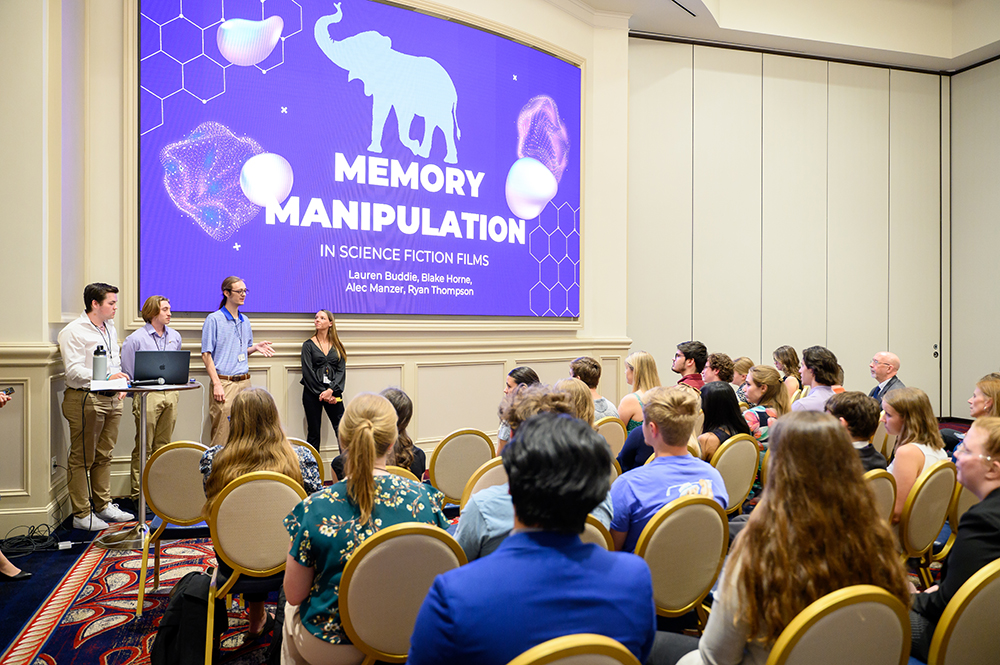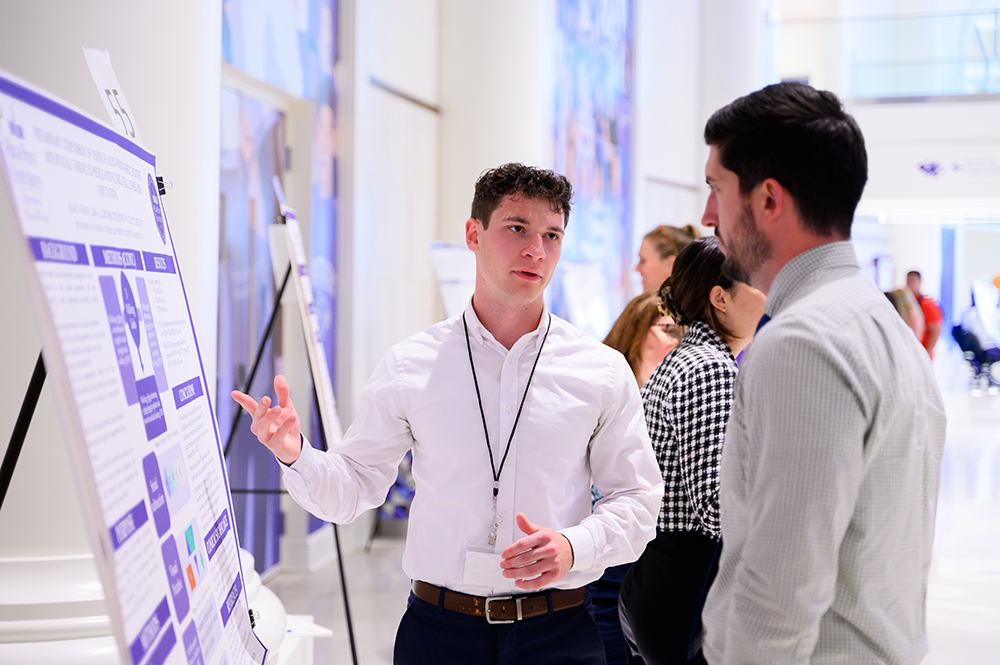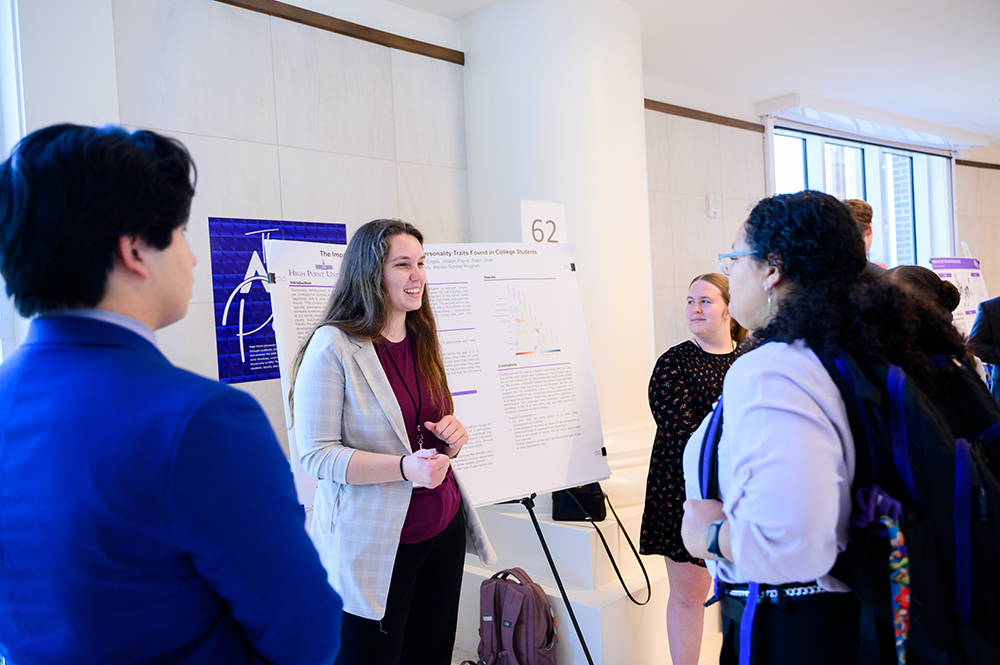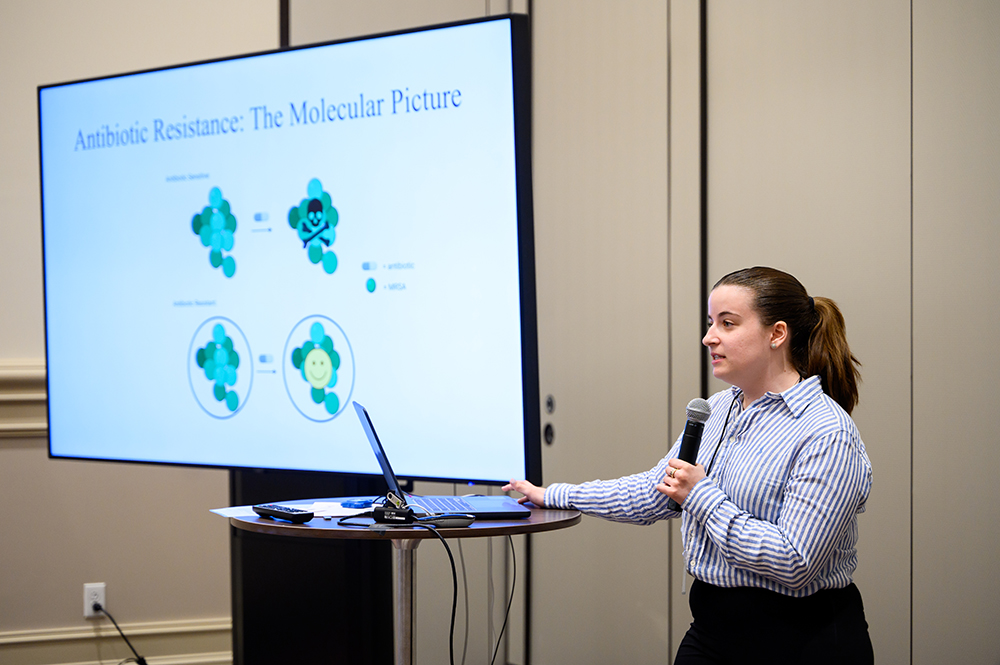High Point University devoted a day to academic achievements and undergraduate research on April 19 at the 11th Annual Research and Creativity Symposium, known as High-PURCS. Pictured from left to right are High Point University freshman Cam Siler-Nixon, senior Marlo Hemerson and senior Sophia Gregory discussing their academic research with event attendees.
HIGH POINT, N.C., April 21, 2023 – Hundreds of High Point University students shared the results of their long-term research projects at the university’s 11th annual Research and Creativity Symposium on April 19. Known as High-PURCS, the day-long event took place in the Nido and Mariana R. Qubein Arena and Conference and was sponsored by HPU’s Office of Undergraduate and Creative Works.
High-PURCS gives students the chance to conduct year- and semester-long extracurricular research projects and to share their results on campus with other students, faculty and staff. Some teams and solo researchers gave oral presentations while others defended their work using poster-style exhibits.

“Presenting at High-PURCS builds students’ confidence to get up and sell their ideas,” said Dr. Joanne Altman, director of HPU’s Office of Undergraduate Research and Creative Works. “Research shows that employers want to see creative thinking, problem-solving skills and the ability to communicate clearly. High-PURCS gives employers concrete evidence that our students have the skill sets they seek.”
More than 250 students teamed up to carry out 154 research projects in this year’s research extravaganza. They filled HPU’s Qubein Arena concourse with poster displays that highlighted their fact-finding investigations during the fall 2022 and spring 2023 semesters. Research topics spanned more than 30 academic disciplines. They ranged from robotics, biochemistry, data analytics, history, mathematical sciences, pharmacy and psychology to dance and music.

Physics major Lorenzo Botter collaborated with Dr. Yong Wei, a professor of computer science, on research to create artificial intelligence software that teaches itself to hunt, identify and stop malware that hackers use to penetrate business and personal computer systems.
“Working on this research and presentation challenged me to use a broad number of different skills,” said Botter, who will pursue a master’s in aeronautics and astronautics at Stanford this fall. “I’m glad I did this work. My weekly one-on-ones with Dr. Wei helped me a lot. The knowledge I got from the topics I studied in-depth with him went far beyond what we explored in class.”
Thanks to High-PURCS, Botter co-authored a paper on the subject with Wei. They will submit their work to a leading computer science journal.

Junior Alec Manzer began his undergraduate research during his freshman year in the Research Rookies program. This opportunity, which is offered by the Office of Undergraduate Research and Creative Works, gives freshmen the chance to jump into the university’s culture of extracurricular research when they first arrive on campus. Manzer targeted his research this year on memory manipulation in the science fiction films “Total Recall,” “Blade Runner” and “Inception.”

“I wanted to do something outside my comfort zone in a cross-disciplinary way that combined psychology, philosophy and film studies,” said Manzer, an Honors Scholar student and biochemistry major from Hammonton, New Jersey. “My team and I did this project as a warning. Even though you can’t implant memories the way it’s done in movies, there are a lot of psychological tricks to convince people that untrue things are true.”

Many students like chemistry major Sophia Gregory hone their research skills by doing High-PURCS projects every year. For her third annual presentation, she used ultraviolet-visible spectroscopy to learn how differing concentrations of phenolics and flavonoids affect the taste and color of merlot and chardonnay alcohol-free or alcoholic wines.
“I worked hands-on with the UV-Vis spectrophotometer every single week,” said Gregory, who is from Camp Hill, Pennsylvania and will go on to Notre Dame’s Ph.D. chemistry program this fall. “At a bigger university, I wouldn’t have been able to touch an instrument like that.”
“High-PURCS was a wonderful opportunity to get involved in research early in my college career,” she said. “It was a great opportunity to present in front of my HPU peers and professors and show off skills I learned.”
